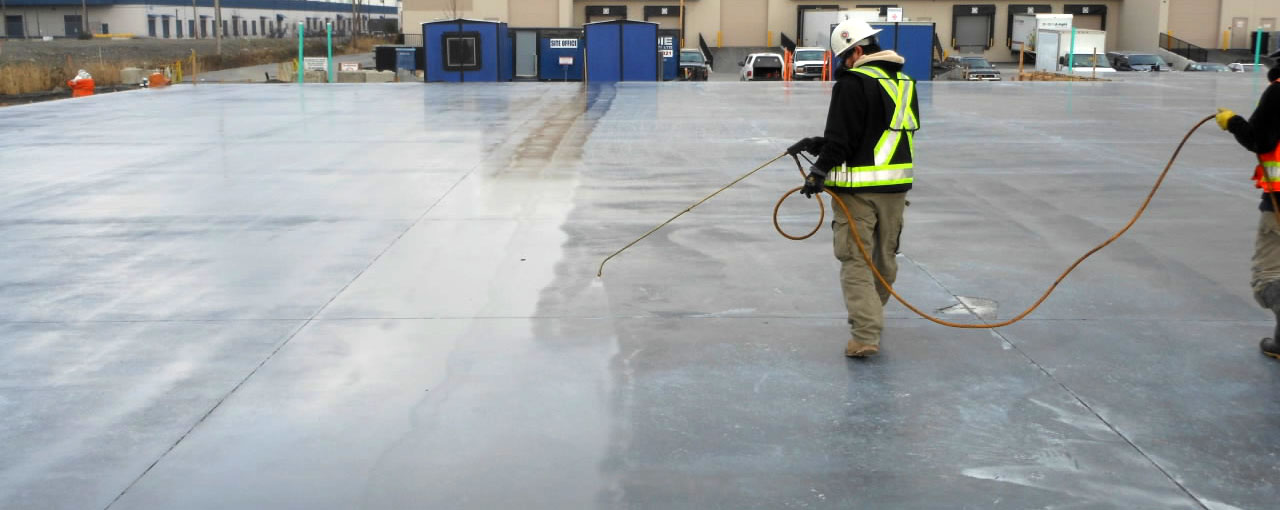ASTM C309 has long been the standard by which membrane-forming concrete curing compounds are judged.
While applicable for its time and still a valid indicator when dealing with rougher finished concrete, the preparation method prescribed by ASTM C156 and then tested by ASTM C309 does not take into account current finishing techniques involved with today’s steel troweled floor slabs. To understand why this is relevant, the preparation procedures for the test itself need to be understood to make a comparison to the specific type of finish being discussed here.
ASTM C156 dictates that the specimen being tested is to be finished by “…using a wood float with one pass only…”. While this technique could closely resemble the finish expected on a driveway or exterior concrete paving, one can safely assume that a floor slab finished using this method would not be acceptable in any industrial setting or big box store type application.
In contrast, today’s industrial floor slabs (and tilt-up casting beds) are being extremely tightly finished using heavy ride-on trowel machines with steel blades to a level of surface density never seen before in the industry. Naturally, this practice alone will produce a much tighter surface than the wood float finish prescribed by ASTM C156, and thus have a greater increase in moisture retention without consideration of a chemical curing compound, and not addressed by the parameters set forth in ASTM C156 and then tested by ASTM C309.
In a quest to gain scientific insight into the difference between finishing techniques as it relates to curing compounds, Nox-Crete has contracted with an independent certified lab to test the effectiveness of Silcoseal EX, Silcoseal Select, Silcoseal 2000F, and Silcoseal Classic as a curing compound on a hard steel trowel finish slab.
However, in order to achieve such testing, it was first necessary to establish a standard for a true “steel troweled finish.” Since there is no established standard preparation technique addressed in the US, Nox-Crete sought out a solution and found the European Committee for Standardization test standard CEN/TS 14754. This test method has a clearly defined and repeatable procedure for preparing a concrete test specimen with a steel hand troweled finish. With this standard test method in hand, any testing laboratory would be able to remove variables in the preparation process and be assured they were testing the exact same finish every time.
Using the defined test methods of ASTM C156 and CEN/TS 14754, concrete test specimens were prepared and testing was initiated to ascertain the following:
What is the improvement in water retention capability of concrete by finishing with a steel trowel (CEN/TS 14754) vs wood float finish (ASTM C156)?
Simply by the merit of using a steel hand trowel to finish the concrete test specimens, a water retention gain of 18% was achieved over the specified wood hand float finish.
What is the effectiveness of Silcoseal EX, Silcoseal Select, Silcoseal 2000F, and Silcoseal Classic, as a curing compound when tested in accordance with ASTM C156 and ASTM C309 standards modified according to CEN/TS 14754?
Silcoseal EX, Silcoseal Select, Silcoseal 2000F, and Silcoseal Classic all met the ASTM C309 72-hour moisture loss benchmark of 0.55 kg/sm when applied to a concrete surface finished with a steel trowel under the guidelines set forth in CEN/TS 14754.
These findings by an independent testing laboratory confirm that Silcoseal Select, Silcoseal 2000F, and Silcoseal Classic are not only excellent bondbreakers, but also excellent curing compounds.
To best summarize the multiple advantages of the Silcoseal line of bondbreakers, it may be best to think of what contractors can take away from a job:
-Elimination of any possible compatibility issues since the same chemical is being used as a cure and a bondbreaker.
-Elimination of possible jobsite confusion as to which product is applied where and in what order, thanks to a single-product application of all Silcoseal products.
-Reduced floor cleaning costs. Heavy membrane-forming cures typically require an arduous and costly removal process. Silcoseal is usually removed with minimal effort using Nox-Crete’s BioClean Plus.
-Less time spent on subsequent coverings or finishes-- using Silcoseal for the initial cure coat allows subsequent coats to lay out better and leads to improved coverage rates and efficiency.
Using historical and established testing criteria coupled with modern standards of concrete finishing, this information has the capability to move the tilt-up industry into a new era of productivity and simplicity. Nox-Crete remains at the forefront of involvement and innovation in this transition and in the future for new products and improved procedures.
 chemical solutions to concrete problems
chemical solutions to concrete problems